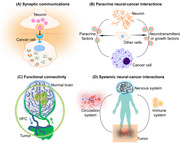- Record: found
- Abstract: found
- Article: found
Progress in cancer neuroscience

Read this article at
Abstract
Cancer of the central nervous system (CNS) can crosstalk systemically and locally in the tumor microenvironment and has become a topic of attention for tumor initiation and advancement. Recently studied neuronal and cancer interaction fundamentally altered the knowledge about glioma and metastases, indicating how cancers invade complex neuronal networks. This review systematically discussed the interactions between neurons and cancers and elucidates new therapeutic avenues. We have overviewed the current understanding of direct or indirect communications of neuronal cells with cancer and the mechanisms associated with cancer invasion. Besides, tumor‐associated neuronal dysfunction and the influence of cancer therapies on the CNS are highlighted. Furthermore, interactions between peripheral nervous system and various cancers have also been discussed separately. Intriguingly and importantly, it cannot be ignored that exosomes could mediate the “wireless communications” between nervous system and cancer. Finally, promising future strategies targeting neuronal–brain tumor interactions were reviewed. A great deal of work remains to be done to elucidate the neuroscience of cancer, and future more research should be directed toward clarifying the precise mechanisms of cancer neuroscience, which hold enormous promise to improve outcomes for a wide range of malignancies.
Abstract
Neurons and cancer cells’ synaptic communication can modulate cancer growth via neurotransmitters and voltage‐mediated mechanisms. Besides, paracrine signaling between cancer and nerve cells, for instance, the neuron‐mediated secretion of growth factors or neurotransmitters, modulates cancer growth in various tissues. The neuronal influence on malignant cells might be direct or affect other cells in TME. Cancer‐induced paracrine factors modulate nervous system to enhance neural activity in TME. Furthermore, cancers functionally control neural networks, and aberrant neural circuits stimulate tumor progression. Circulating factors released from cancer effects nervous system activity, whereas nervous system influences cancer growth by circulating molecules (hormones and progenitor cells) and alters immune system function.
Related collections
Most cited references202
- Record: found
- Abstract: found
- Article: not found
Exosome-mediated transfer of mRNAs and microRNAs is a novel mechanism of genetic exchange between cells.
- Record: found
- Abstract: found
- Article: not found
Hallmarks of Cancer: New Dimensions
- Record: found
- Abstract: found
- Article: not found
